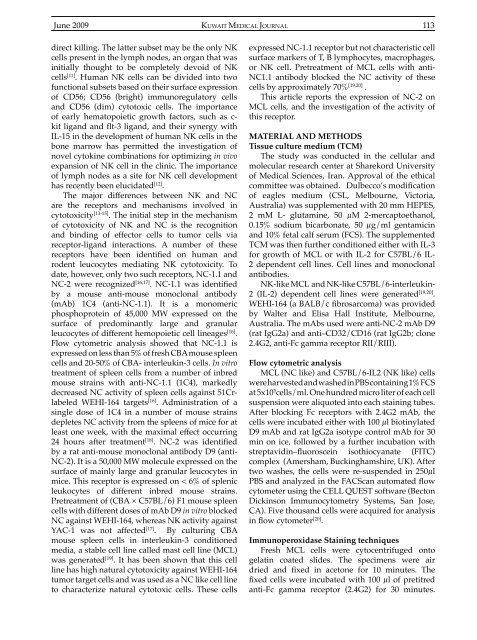June 09-41-2.indd - Kma.org.kw
June 09-41-2.indd - Kma.org.kw
June 09-41-2.indd - Kma.org.kw
You also want an ePaper? Increase the reach of your titles
YUMPU automatically turns print PDFs into web optimized ePapers that Google loves.
<strong>June</strong> 20<strong>09</strong>KUWAIT MEDICAL JOURNAL 113direct killing. The latter subset may be the only NKcells present in the lymph nodes, an <strong>org</strong>an that wasinitially thought to be completely devoid of NKcells [11] . Human NK cells can be divided into twofunctional subsets based on their surface expressionof CD56; CD56 (bright) immunoregulatory cellsand CD56 (dim) cytotoxic cells. The importanceof early hematopoietic growth factors, such as c-kit ligand and flt-3 ligand, and their synergy withIL-15 in the development of human NK cells in thebone marrow has permitted the investigation ofnovel cytokine combinations for optimizing in vivoexpansion of NK cell in the clinic. The importanceof lymph nodes as a site for NK cell developmenthas recently been elucidated [12] .The major differences between NK and NCare the receptors and mechanisms involved incytotoxicity [13-15] . The initial step in the mechanismof cytotoxicity of NK and NC is the recognitionand binding of effector cells to tumor cells viareceptor-ligand interactions. A number of thesereceptors have been identified on human androdent leucocytes mediating NK cytotoxicity. Todate, however, only two such receptors, NC-1.1 andNC-2 were recognized [16,17] . NC-1.1 was identifiedby a mouse anti-mouse monoclonal antibody(mAb) 1C4 (anti-NC-1.1). It is a monomericphosphoprotein of 45,000 MW expressed on thesurface of predominantly large and granularleucocytes of different hemopoietic cell lineages [16] .Flow cytometric analysis showed that NC-1.1 isexpressed on less than 5% of fresh CBA mouse spleencells and 20-50% of CBA- interleukin-3 cells. In vitrotreatment of spleen cells from a number of inbredmouse strains with anti-NC-1.1 (1C4), markedlydecreased NC activity of spleen cells against 51CrlabeledWEHI-164 targets [16] . Administration of asingle dose of 1C4 in a number of mouse strainsdepletes NC activity from the spleens of mice for atleast one week, with the maximal effect occurring24 hours after treatment [18] . NC-2 was identifiedby a rat anti-mouse monoclonal antibody D9 (anti-NC-2). It is a 50,000 MW molecule expressed on thesurface of mainly large and granular leucocytes inmice. This receptor is expressed on < 6% of splenicleukocytes of different inbred mouse strains.Pretreatment of (CBA × C57BL/6) F1 mouse spleencells with different doses of mAb D9 in vitro blockedNC against WEHI-164, whereas NK activity againstYAC-1 was not affected [17] . By culturing CBAmouse spleen cells in interleukin-3 conditionedmedia, a stable cell line called mast cell line (MCL)was generated [19] . It has been shown that this cellline has high natural cytotoxicity against WEHI-164tumor target cells and was used as a NC like cell lineto characterize natural cytotoxic cells. These cellsexpressed NC-1.1 receptor but not characteristic cellsurface markers of T, B lymphocytes, macrophages,or NK cell. Pretreatment of MCL cells with anti-NC1.1 antibody blocked the NC activity of thesecells by approximately 70% [19,20] .This article reports the expression of NC-2 onMCL cells, and the investigation of the activity ofthis receptor.MATERIAL AND METHODSTissue culture medium (TCM)The study was conducted in the cellular andmolecular research center at Sharekord Universityof Medical Sciences, Iran. Approval of the ethicalcommittee was obtained. Dulbecco’s modificationof eagles medium (CSL, Melbourne, Victoria,Australia) was supplemented with 20 mm HEPES,2 mM L- glutamine, 50 µM 2-mercaptoethanol,0.15% sodium bicarbonate, 50 µg/ml gentamicinand 10% fetal calf serum (FCS). The supplementedTCM was then further conditioned either with IL-3for growth of MCL or with IL-2 for C57BL/6 IL-2 dependent cell lines. Cell lines and monoclonalantibodies.NK-like MCL and NK-like C57BL/6-interleukin-2 (IL-2) dependent cell lines were generated [19,20] .WEHI-164 (a BALB/c fibrosarcoma) was providedby Walter and Elisa Hall Institute, Melbourne,Australia. The mAbs used were anti-NC-2 mAb D9(rat IgG2a) and anti–CD32/CD16 (rat IgG2b; clone2.4G2, anti-Fc gamma receptor RII/RIII).Flow cytometric analysisMCL (NC like) and C57BL/6-IL2 (NK like) cellswere harvested and washed in PBS containing 1% FCSat 5x10 5 cells/ml. One hundred micro liter of each cellsuspension were aliquoted into each staining tubes.After blocking Fc receptors with 2.4G2 mAb, thecells were incubated either with 100 µl biotinylatedD9 mAb and rat IgG2a isotype control mAb for 30min on ice, followed by a further incubation withstreptavidin–fluoroscein isothiocyanate (FITC)complex (Amersham, Buckinghamshire, UK). Aftertwo washes, the cells were re-suspended in 250µlPBS and analyzed in the FACScan automated flowcytometer using the CELL QUEST software (BectonDickinson Immunocytometry Systems, San Jose,CA). Five thousand cells were acquired for analysisin flow cytometer [20] .Immunoperoxidase Staining techniquesFresh MCL cells were cytocentrifuged ontogelatin coated slides. The specimens were airdried and fixed in acetone for 10 minutes. Thefixed cells were incubated with 100 µl of pretitredanti-Fc gamma receptor (2.4G2) for 30 minutes.
















